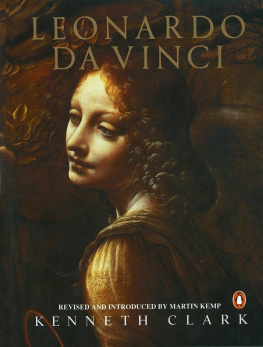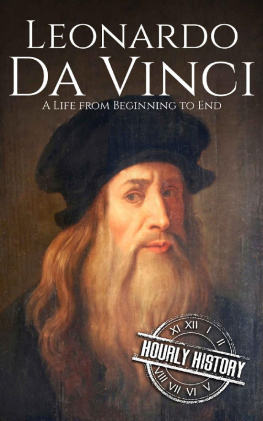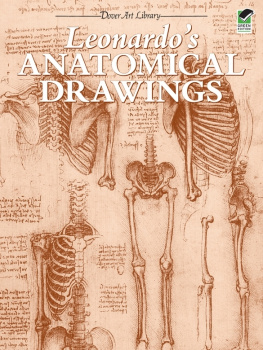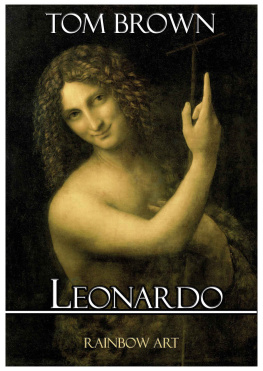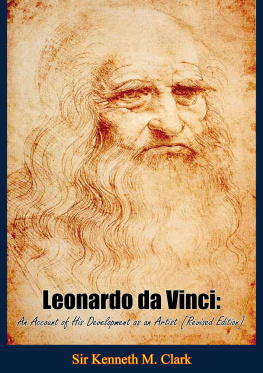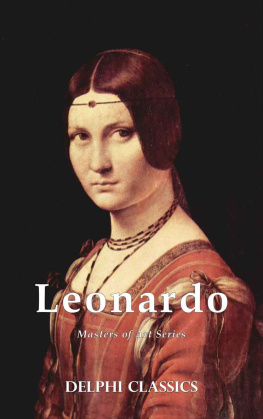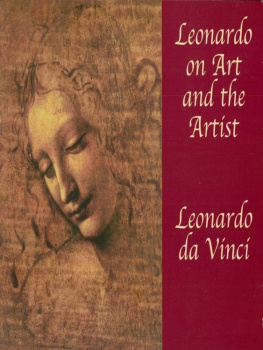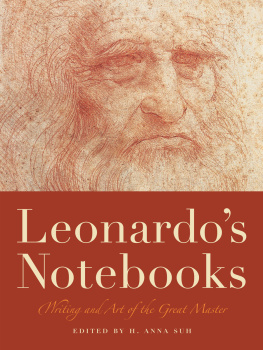Kenneth Clark - Leonardo da Vinci
Here you can read online Kenneth Clark - Leonardo da Vinci full text of the book (entire story) in english for free. Download pdf and epub, get meaning, cover and reviews about this ebook. year: 2015, publisher: Penguin Books, genre: Detective and thriller. Description of the work, (preface) as well as reviews are available. Best literature library LitArk.com created for fans of good reading and offers a wide selection of genres:
Romance novel
Science fiction
Adventure
Detective
Science
History
Home and family
Prose
Art
Politics
Computer
Non-fiction
Religion
Business
Children
Humor
Choose a favorite category and find really read worthwhile books. Enjoy immersion in the world of imagination, feel the emotions of the characters or learn something new for yourself, make an fascinating discovery.
- Book:Leonardo da Vinci
- Author:
- Publisher:Penguin Books
- Genre:
- Year:2015
- Rating:5 / 5
- Favourites:Add to favourites
- Your mark:
- 100
- 1
- 2
- 3
- 4
- 5
Leonardo da Vinci: summary, description and annotation
We offer to read an annotation, description, summary or preface (depends on what the author of the book "Leonardo da Vinci" wrote himself). If you haven't found the necessary information about the book — write in the comments, we will try to find it.
Leonardo da Vinci — read online for free the complete book (whole text) full work
Below is the text of the book, divided by pages. System saving the place of the last page read, allows you to conveniently read the book "Leonardo da Vinci" online for free, without having to search again every time where you left off. Put a bookmark, and you can go to the page where you finished reading at any time.
Font size:
Interval:
Bookmark:



UK | USA | Canada | Ireland | Australia
India | New Zealand | South Africa
Penguin Books is part of the Penguin Random House group of companies whose addresses can be found at global.penguinrandomhouse.com.

First published by Cambridge University Press 1939
Revised edition published by Penguin Books 1959
Reprinted with revisions 1967
Published with revisions and an Introduction by Viking 1988
Published in Pelican Books 1989
Reprinted in Penguin Books 1993
Copyright 1939 by Kenneth Clark
Introduction and revisions copyright Martin Kemp, 1988
All rights reserved
ISBN: 978-0-141-98237-3
PENGUIN BOOKS
Kenneth Clark was born in 1902. He was educated at Winchester and Oxford and worked for two years with Bernard Berenson in Florence. He was appointed Director of the National Gallery at the age of thirty and remained there until 1945. During the war he organized the war artists scheme and, with Dame Myra Hess, was responsible for the National Gallery Concerts. He was Slade Professor of Fine Art at Oxford from 1946 to 1950. Lord Clark was Chairman of the Arts Council from May 1953 to 1960 and was appointed Chairman on the setting up of the Independent Television Authority. He was widely known for his television programmes on art, especially the series Civilisation. His first publication, written at the age of twenty-two, was The Gothic Revival, and many others followed; four of them, Leonardo da Vinci (1939), Landscape into Art (1949), The Nude (1956) and Ruskin Today (1964), have been published by Penguin. His later works are Rembrandt and the Italian Renaissance (1966), A Failure of Nerve (1967), Civilisation (1969), Looking at Pictures (1972), Westminster Abbey (1972; jointly), The Artist Grows Old (Rede Lecture, 1972), The Romantic Rebellion (1973), Another Part of the Wood, the first volume of his autobiography (1974), Henry Moore Drawings (1974), The Drawings by Sandro Botticelli for Dantes Divine Comedy (1976), The Other Half, the second volume of his autobiography (1978), Animals and Men (1977), An Introduction to Rembrandt (1978), The Best of Aubrey Beardsley (1978) and Moments of Vision (1981). He was made a life peer in 1969. Among other honours conferred, he was made an Honorary Fellow of the Royal Institute of British Architects and Honorary Fellow of the Royal Academy of Arts. In 1970 he was awarded the US National Gallery of Arts medal and, in 1976, the Order of Merit. Lord Clark died in May 1983.
Martin Kemp is Professor of Fine Arts at the University of St Andrews.

Let the conversation begin...
Follow the Penguin Twitter.com@penguinukbooks
Keep up-to-date with all our stories YouTube.com/penguinbooks
Pin Penguin Books to your Pinterest
Like Penguin Books on Facebook.com/penguinbooks
Listen to Penguin at SoundCloud.com/penguin-books
Find out more about the author and
discover more stories like this at Penguin.co.uk

Plates added to Clarks original list are marked*.
The dates given for undocumented works are deduced from Clarks text, the original list of plates and chronology.
All works are by Leonardo unless specifically indicated.
Windsor Castle, Royal Library, by Gracious Permission of Her Majesty the Queen: .
CLARKS LEONARDO
The daunting body of literature on Leonardo contains its fair share of lunacy and more than its fair measure of scholarly nit-picking. However, it also includes a significant quantity of writing that presents exciting insights into the masters works and is worth reading in its own right. I doubt whether the writing on other major artists, Michelangelo for instance, can lay claim to comparable peaks of literary excellence. The names of four authors cited prominently in Clarks text Goethe, Pater, Valry and Freud testify to the quality of earlier minds drawn to Leonardos seductive genius. In Vasaris Lives of the Artists, the great sixteenth-century compendium which is the first masterpiece of historical writing on the visual arts, Leonardo receives what is probably the most compellingly personal portrait of all, although Michelangelos life provides the ostensible climax of the series. Clarks monograph is in every respect a creatively worthy member of the tradition of Leonardo biography that runs from Vasari.
Kenneth Clarks Leonardo da Vinci: An Account of his Development as an Artist was first published in 1939 and stands at the mature climax of his remarkably precocious career as a writer on the visual arts. This is not to say that his later writing or extensive activities as a broadcaster should be regarded as a decline, but I think it is true to say that his aesthetic sensibility, literary gifts and powers of scholarship were never again to be seen together in such a delicate and satisfying equilibrium. Looking at the story of Clarks life during his formative years, we can see these various elements entering his life and being absorbed within his developing intellect.
The Even allowing for a degree of retrospective romanticism in the autobiography I was walking on air, he recalls this and other incidents suggest that what he called his sense of pure aesthetic sensation had begun to manifest itself at a remarkably early age.
Throughout his career the conviction that aesthetic response is an identifiable and distinct property of the human mind remained central to his practice of art criticism. In Clarks own case this response embraced music, literature and the theatre no less keenly than the visual arts. The authors to whom he was most immediately drawn were those in whom he sensed this inner response at the highest level. Amongst writers on art, Walter Pater remained the supreme exemplar. Paters famous words on the Mona Lisa a beauty wrought out from within upon the flesh, the deposit, little cell by little cell, of strange thoughts and fantastic reveries and exquisite passions became the passage most often quoted in his writings, appearing as early as 1929 and as late as 1973. In literary and aesthetic terms, the challenge of Paters 1869 essay on Leonardo plays a prominent role in Clarks monograph.
The aesthetic precociousness that seems to have earned him some measure of distrust from his schoolboy contemporaries at Winchester, where he nurtured an early ambition to become a painter, found an environment in which to flourish at Oxford, where he went to study history in 1922. The most important result of his insinuating himself into artistic circles in Oxford was that he was permitted by C. R. (Charlie) Bell, the idiosyncratic Keeper of the Department of Fine Art at the Ashmolean Museum, to gain sustained access to the outstanding collection of Old Master drawings. With Robinsons venerable catalogue in his hand, the undergraduate Clark trained his eye directly on the intense study of original drawings by Raphael and Michelangelo. Bells support was crucial in more than this respect: it was he who proposed that Clark should write a book on the Gothic revival after graduation, and effected the introduction to Bernard Berenson in Italy that did so much to promote Clarks meteoric rise.
Font size:
Interval:
Bookmark:
Similar books «Leonardo da Vinci»
Look at similar books to Leonardo da Vinci. We have selected literature similar in name and meaning in the hope of providing readers with more options to find new, interesting, not yet read works.
Discussion, reviews of the book Leonardo da Vinci and just readers' own opinions. Leave your comments, write what you think about the work, its meaning or the main characters. Specify what exactly you liked and what you didn't like, and why you think so.

